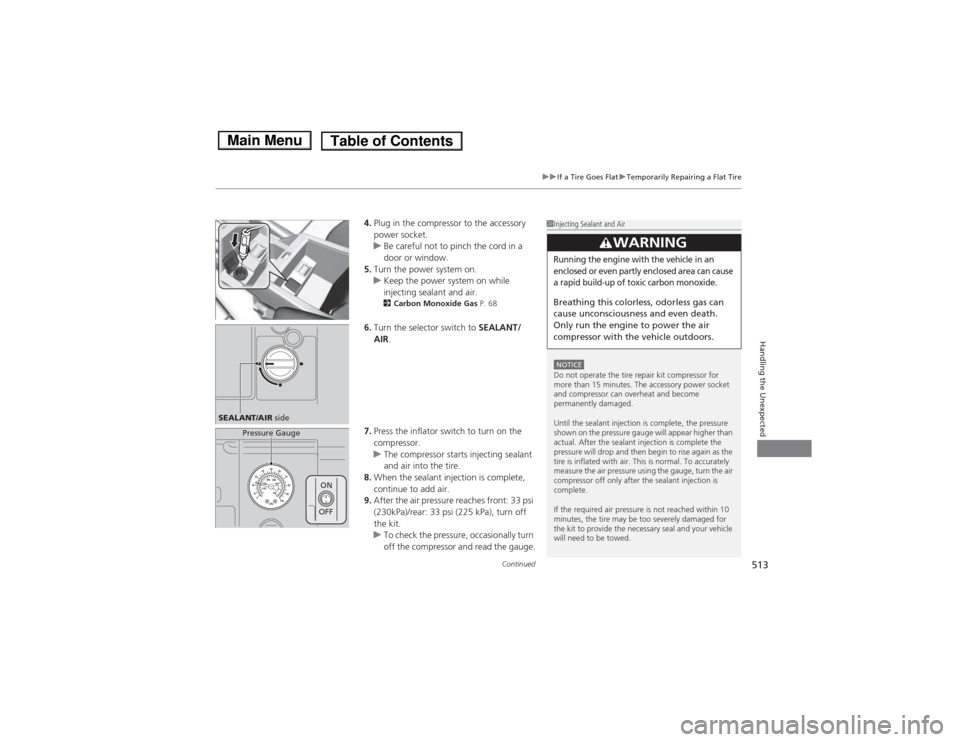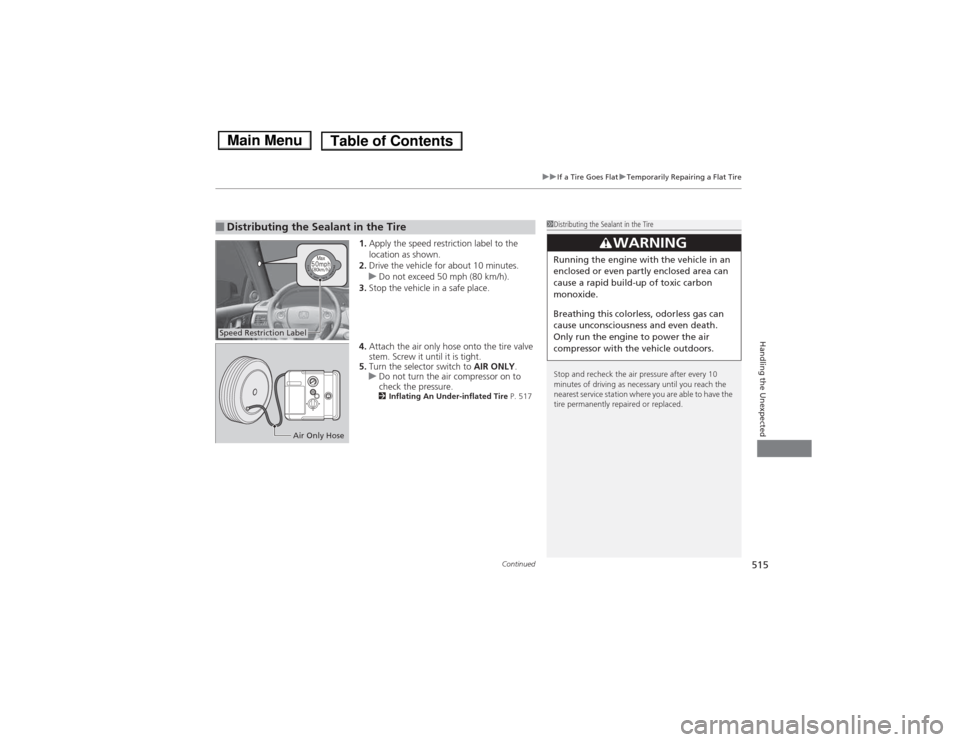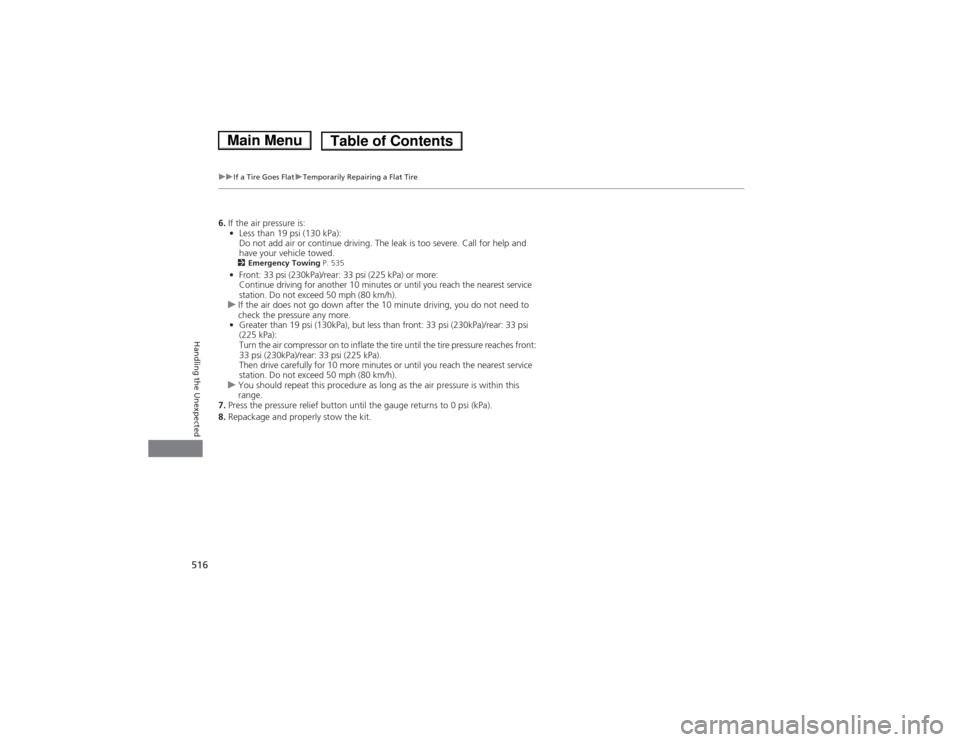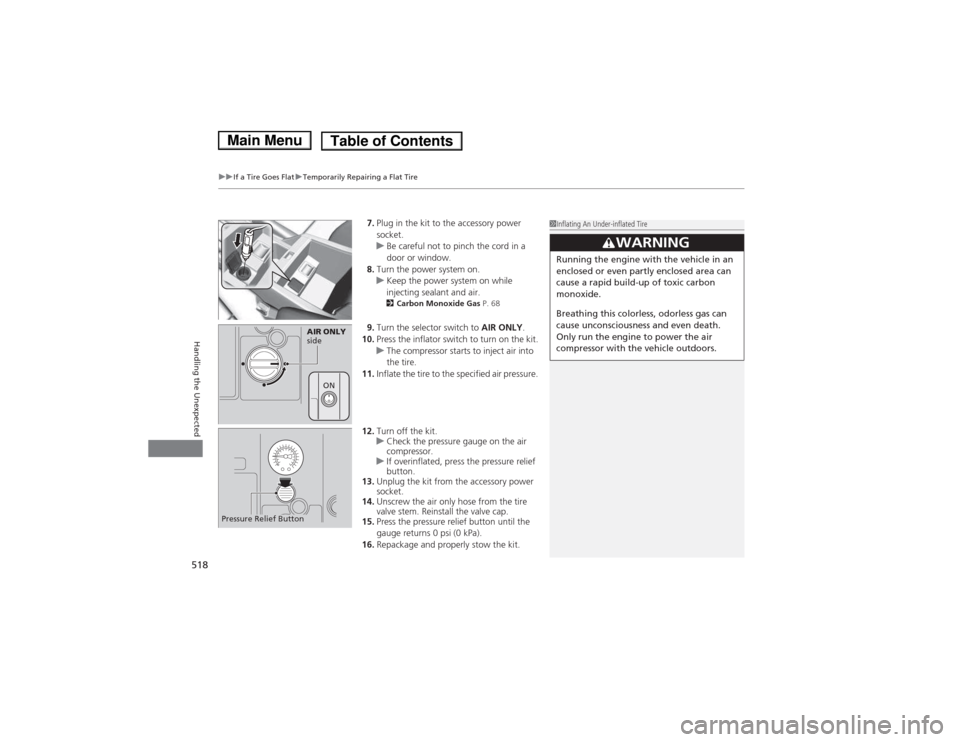Page 514 of 561

Continued513
uuIf a Tire Goes FlatuTemporarily Repairing a Flat Tire
Handling the Unexpected
4.Plug in the compressor to the accessory power socket.
uBe careful not to pinch the cord in a
door or window.
5. Turn the power system on.
uKeep the power system on while
injecting sealant and air.
2 Carbon Monoxide Gas P. 68
6. Turn the selector switch to SEALANT/
AIR .
7. Press the inflator switch to turn on the
compressor.
uThe compressor starts injecting sealant
and air into the tire.
8. When the sealant injection is complete,
continue to add air.
9. After the air pressure reaches front: 33 psi
(230kPa)/rear: 33 psi (225 kPa), turn off
the kit.
uTo check the pressure, occasionally turn
off the compressor and read the gauge.
1Injecting Sealant and Air
NOTICEDo not operate the tire repair kit compressor for
more than 15 minutes. The accessory power socket
and compressor can overheat and become permanently damaged.
Until the sealant injection is complete, the pressure
shown on the pressure gauge will appear higher than
actual. After the sealant injection is complete the
pressure will drop and then begin to rise again as the
tire is inflated with air. This is normal. To accurately
measure the air pressure using the gauge, turn the air
compressor off only after the sealant injection is complete.
If the required air pressure is not reached within 10
minutes, the tire may be too severely damaged for
the kit to provide the necessary seal and your vehicle
will need to be towed.
3WARNING
Running the engine with the vehicle in an
enclosed or even partly enclosed area can cause
a rapid build-up of toxic carbon monoxide.
Breathing this colorless, odorless gas can
cause unconsciousness and even death.
Only run the engine to power the air
compressor with the vehicle outdoors.
SEALANT/AIR side
Pressure Gauge
ON
OFF
Main MenuTable of Contents
Page 516 of 561

Continued515
uuIf a Tire Goes FlatuTemporarily Repairing a Flat Tire
Handling the Unexpected
1.Apply the speed restriction label to the
location as shown.
2. Drive the vehicle for about 10 minutes.
uDo not exceed 50 mph (80 km/h).
3. Stop the vehicle in a safe place.
4. Attach the air only hose onto the tire valve
stem. Screw it until it is tight.
5. Turn the selector switch to AIR ONLY.
uDo not turn the air compressor on to
check the pressure.
2 Inflating An Under-inflated Tire P. 517
■Distributing the Sealant in the Tire1Distributing the Sealant in the Tire
Stop and recheck the air pressure after every 10
minutes of driving as necessary until you reach the
nearest service station where you are able to have the
tire permanently repaired or replaced.
3WARNING
Running the engine with the vehicle in an
enclosed or even partly enclosed area can
cause a rapid build-up of toxic carbon monoxide.
Breathing this colorless, odorless gas can
cause unconsciousness and even death.
Only run the engine to power the air
compressor with the vehicle outdoors.
Speed Restriction Label
Air Only Hose
Main MenuTable of Contents
Page 517 of 561

516
uuIf a Tire Goes FlatuTemporarily Repairing a Flat Tire
Handling the Unexpected
6.If the air pressure is:
• Less than 19 psi (130 kPa):
Do not add air or continue driving. The leak is too severe. Call for help and
have your vehicle towed.
2 Emergency Towing P. 535
• Front: 33 psi (230kPa)/rear: 33 psi (225 kPa) or more:
Continue driving for another 10 minutes or until you reach the nearest service
station. Do not exceed 50 mph (80 km/h).
uIf the air does not go down after the 10 minute driving, you do not need to
check the pressure any more.
• Greater than 19 psi (130kPa), but less than front: 33 psi (230kPa)/rear: 33 psi
(225 kPa):
Turn the air compressor on to inflate the tire until the tire pressure reaches front:
33 psi (230kPa)/rear: 33 psi (225 kPa).
Then drive carefully for 10 more minutes or until you reach the nearest service
station. Do not exceed 50 mph (80 km/h).
uYou should repeat this procedure as long as the air pressure is within this range.
7. Press the pressure relief button until the gauge returns to 0 psi (kPa).
8. Repackage and properly stow the kit.
Main MenuTable of Contents
Page 518 of 561
Continued517
uuIf a Tire Goes FlatuTemporarily Repairing a Flat Tire
Handling the Unexpected
You can use the kit to inflate a non-punctured under-inflated tire.
1.Open the trunk floor lid.
2 Getting Ready to Temporarily Repair
the Flat Tire P. 511
2. Remove the kit from the case.
uPlace the kit on flat ground near the tire
to be inflated, away from traffic.
3. Place the kit, face up, on flat ground near
the flat tire, away from traffic. Do not
place the kit on its side.
4. Remove the air only hose from the kit.
5. Remove the valve cap.
6. Attach the air only hose onto the tire valve
stem. Screw it until it is tight.
■Inflating An Under-inflated Tire1Inflating An Under-inflated Tire
NOTICEDo not operate the temporary tire repair kit
compressor for more than 15 minutes. The accessory
power socket and compressor can overheat and become permanently damaged.
Air Only Hose
Valve Cap
Valve Stem
Air Only Hose
Main MenuTable of Contents
Page 519 of 561

uuIf a Tire Goes FlatuTemporarily Repairing a Flat Tire
518
Handling the Unexpected
7. Plug in the kit to the accessory power socket.
uBe careful not to pinch the cord in a
door or window.
8. Turn the power system on.
uKeep the power system on while
injecting sealant and air.
2 Carbon Monoxide Gas P. 68
9. Turn the selector switch to AIR ONLY.
10. Press the inflator switch to turn on the kit.
uThe compressor starts to inject air into
the tire.
11. Inflate the tire to the specified air pressure.
12. Turn off the kit.
uCheck the pressure gauge on the air
compressor.
uIf overinflated, press the pressure relief button.
13. Unplug the kit from the accessory power socket.
14. Unscrew the air only hose from the tire
valve stem. Reinstall the valve cap.
15. Press the pressure relief button until the
gauge returns 0 psi (0 kPa).
16. Repackage and properly stow the kit.
1Inflating An Under-inflated Tire
3WARNING
Running the engine with the vehicle in an
enclosed or even partly enclosed area can
cause a rapid build-up of toxic carbon monoxide.
Breathing this colorless, odorless gas can
cause unconsciousness and even death.
Only run the engine to power the air
compressor with the vehicle outdoors.
AIR ONLY
side
ON
Pressure Relief Button
Main MenuTable of Contents